 |
Stories & Legends
A Renewed Interest in Mary Gardens
Margaret C. Galitzin
The charming article about the “higher significance of things” inspired what - for one brief moment - I thought was an original idea. Why not make a Mary garden, a flower garden dedicated to Our Lady planted only in flowers whose names refer to her in some way? What a lovely way to honor the Blessed Virgin, who is always so ready to assist us in our daily needs.
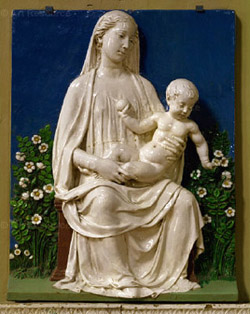
Rose Campions star-like form reminds us of Mary, Star of the Sea |
It didn’t take long to find that the Mary garden is an old idea, a very old one indeed, which dates back to the Middle Ages when many flowers referred to the Virgin’s life and virtues. Every monastery and convent had a special Mary garden to provide flowers to adorn the altar. It was because of the abundance of flowers in May that it became Mary’s month, and the people delighted in decorating her statue and altar with flowers.
The little people found their Mary gardens in the field and forests, where so many flowers spoke to them of some aspect of Our Lady and her Divine Son. It is said that then, in those happy days of Faith, the flowers honored Mary, the choicest Flower of All, the Mystical Rose; everyone knew that it was she of whom Solomon sang: I am a rose of Sharon, a lily of the valleys.
Reminders of the Blessed Virgin
The beauty and peculiar characteristics of various flowers reminded the medieval man of Our Lady, and so they received their names.
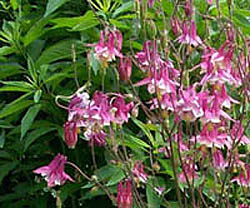
Columbine - Our Lady's Slippers |
The columbine was Our Lady’s Slippers because they seemed like fanciful lady’s slippers. They were said to spring from the earth where Our Lady’s foot stepped on her way to visit her cousin Elizabeth. Another well-known flower, the Sweet William, was Our Lady’s Cushion, because the cluster of delicate flowerets seemed like a fairy-like cushion for their Queen.
The Fuchsia with its gently drooping flowers was Our Lady’s Eardrops. It was easy for the little people to image the Christ Child hanging those flower jewels of ruby and amethyst color on His mother’s ears. The sweet-scented honeysuckle flowers with their delicate long white stems were Our Lady’s Fingers. The rich blanket of blue Morning Glories seemed like Our Lady’s Mantle, and so they named it. The forget-me-not, a clear blue flower with a golden center, was the Eyes of Mary.
Her qualities and virtues
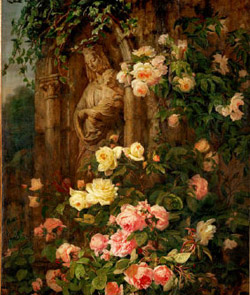
Notre Dame of the Roses by Simon Saint-Jean |
The flowers also spoke of the virtue and qualities of Our Lady. Since the times of early Christianity the rose and lily were identified with Mary. It was only natural that the rose, the most perfect of flowers, should symbolize the Virgin Mary, the most perfect of women. The white rose represented her exquisite purity, the red rose, her profound sorrow, and the yellow rose, her triumphant glory.
The white Madonna lily denoted her immaculate purity, her innocence and her virginity. In the 7th century, the Venerable Bede described it as “the white petals signifying the Virgin Mary’s bodily purity, the golden anthers the glowing light of her soul.” (1)
The tulip, known as Mary’s Prayer, was said to represent Mary’s fullness of grace. Its upward-facing cup or chalice reflected Our Lady’s openness to and filling with grace.
Episodes from the life of the Holy Family
Other flora names sprung from legends regarding the life of the Holy Family. Lavender was called Mary’s Drying Plant because, so the story goes, Our Lady hung the Divine Infant’s clothing to dry on a gray lavender bush. From the blankets of the Son of God, the plant took its sweet scent and lavender color.Similar stories are told of rosemary – St. Mary’s Tree – and other sweet-scented shrubs.
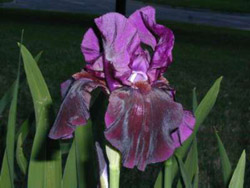
Iris - Mary's Sword of Sorrow |
Juniper, the Madonna’s Bush was rewarded for its generosity in giving shelter to the Holy Family on its flight to Egypt. And marigolds (Mary’s Gold) spilled out of Mary’s purse when the Holy Family was accosted by robbers during the flight to Egypt.
Many names were born from tender reflections on the Passion of Christ. When the Virgin Mary’s tears fell at the foot of the Cross, the medievals told their children, they turned into the tiny fragrant blossoms of the lily of the valley, that early spring plant called Our Lady’s Tears. The purple flag iris we know so well was called Mary’s Sword of Sorrow. The pointed leaves reminded the medieval man of swords, and then his thought turned naturally to the swords that pierced the Heart of their beloved Mother.
The flower legends grew from the devotion and love of the people, who thought of Mary when they observed the beauties, oddities and distinctive features of the flower world. The names spread and were repeated with small variations throughout Catholic Europe. Today, making a Mary garden is a means to re-find those beautiful names, to reflect again on the “higher significance of things,” to make the flower garden a place of prayer and simple meditation on the life and virtues of Our Lady.
Making your Mary garden
It is not difficult to make your own Mary garden. Quite simply, it is a grouping of flowers, ivy or herbs dedicated to Our Lady. Strictly speaking, all the plants in it should be associated with her in some way. This is not so difficult, since, as noted above, many flower names found inspiration from her life.
If you already have a flower garden, you can dedicate a part of it to the project. It is easy to start with flowers already commonly grown in home gardens in your area which require no special gardening knowledge. This small garden may expand and develop with time. Indoor or patio gardeners can plant different varieties of Marian flowers, herbs or ivy in a single pot, or make a grouping of plants around a statue of the Blessed Virgin
An indoor Mary garden planting in a decorative pot makes a wonderful gift for a friend or elderly person devoted to Our Lady. The Mary garden is also a wonderful class project for the home-schooling family. All the family members can learn the charming old religious names of flowers and herbs and begin again to see the things of Heaven in the world around us.
Mary garden resource
A one-stop web resource for the Mary garden is titled Mary Garden, founded by John S. Stokes, Jr. It offers an extensive archive of articles with information about every aspect of a Mary garden you can imagine. It was, in fact, the primary resource for this article.
On his website, you will find the legends and histories of hundreds of Mary Flowers in England, France, Germany, Ireland, Latin America and Spain. He records the history of the Mary gardens in the United States, beginning with the first Mary garden at Woods Hole on Cape Cod founded in 1932.
One article suggests easy-to-grow, well-known annual flowers for beginning gardeners; another lists 100 plants for a larger Mary garden. The site also gives step-by-step guides to planting Mary gardens for patio, home, parish, indoors and on windowsills, showing representative gardens of each. For the computer-savvy, it points to software programs for designing a “virtual Mary garden.”
Mr. Stokes, rightly considered the founder of the Mary Garden Movement, encouraged the gardens as a simple way to mediate on the virtues of Our Lady. A devotee of St. Louis de Montfort’s True Devotion to Mary, he considered the garden the natural place to develop that devotion. St. Louis de Montfort called Mary “God’s garden of Paradise, into which his Son entered, to tend it and to take delight in it.” (No. 19) When we enter the garden and find Mary, we find that world of delights
*
Below is a list of suggestions for more common perennial, biennial and annual flowers, bulbs and herbs considered flora of Our Lady for planting in your Mary garden:
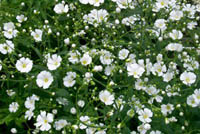
Babies Breath - Our Lady's Veil
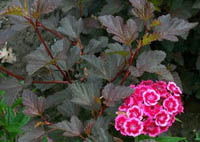
Pinks - Our Lady's Cushion
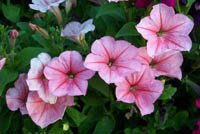
Petunia - Our Lady's Praises
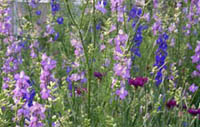
Larkspur - Mary's Tears
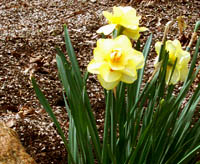
Daffodil - Mary's Star
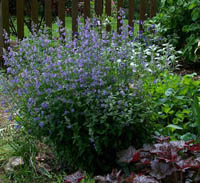
Catnip - Mary's Nettle |
Perennials:
Aster - Mary’s Star
Bachelor’s buttons or cornflowers – Mary’s Crown
Baby’s Breath – Our Lady’s Veil
Carnation – Mother of God’s Love
Chrysanthemum – All Saints’ Flower
Clematis – Virgin’s Bower
Columbine – Mary’s Shoes
Forget-me-not - Eyes of Mary
Geranium – Gentle Virgin
Primrose – Mary’s Candlestick
Violet – Mary’s Humility
Hardy biennials:
English daisy – Mary-Loves
Foxglove – Our Lady’s Gloves
Hollyhock - St. Joseph’s Staff
Pansy – Our Lady’s Delight or Trinity Flower
Sweet William or Pinks – Our Lady’s Cushion
Common garden annuals:
Alyssum – Mary’s Flower, Flower of the Cross
Cornflower – Mary’s Crown
Corn Poppy – Mary’s Button
Gaillardia – The Virgin’s Face
Impatiens - Mother Love
Job’s Tears – Rosary Tears
Larkspur - Mary's Tears
Marigold - Mary's Gold
Morning Glory - Our Lady's Mantle
Petunia - Our Lady's Praises
Poppy - Christ's Blood
Snapdragon - Infant Jesus' Shoes
Sunflower – Mary’s Gold
Sweet Pea – Our Lady’s Flower
Zinnia - The Virgin
Bulbs:
Amaryllis – Beautiful Lady
Daffodils – Mary’s Star
Dahlia – Churchyard flower
Gladiolus – Ladder to Heaven
Grape Hyacinth – Church Steeples
Hyacinth – Lily Among Thorns
Iris or flags - Mary’s Sword of Sorrow
Lily - Madonna Lily or Annunciation Lily
Lily of the Valley – Our Lady’s Tears
Peony – Mary’s Rose
Tulips – Mary’s Prayer
Herbs for your Mary garden:
Basil –Holy Communion Plant
Bee-Balm - Sweet Mary
Catnip – Mary’s Nettle
Chives – Our Lady’s Garlic
Dandelion – Mary’s Bitter Sorrow
Lady’s Mantle – Our Lady’s Mantle
Lavender – Our Lady’s Drying Herb
Lemon Balm – Sweet Mary
Milk Thistle – Our Lady’s Milk Thistle
Peppermint – Our Lady’s Mint
Rosemary – Saint Mary’s Tree
Sage – Our Lady’s Shawl
Spearmint - Marymint
Thyme – Mary’s Bedstraw
Red Clover – Our Lady’s Posies
Rue – Herb of Grace
Tansy – Our Lady’s Plant
1. Vincenzina Krymow, Mary’s Flowers: Gardens, Legends & Meditations, Cincinnati: St. Anthony’s Messenger Press, 1999, p. 28.

Posted May 7, 2008

Related Topics of Interest
 Naivety or a Higher Understanding of Things? Naivety or a Higher Understanding of Things?
 The Middle Ages, a Forest Filled with Symbols The Middle Ages, a Forest Filled with Symbols
 Roses and the Rosary Roses and the Rosary
 Gargoyles and Original Sin Gargoyles and Original Sin
 Vice and Virtue Symbolized in Animals Vice and Virtue Symbolized in Animals
 Snowflakes Reflect the Diversity of God Snowflakes Reflect the Diversity of God
 The Symbol of the Crown in the Reign of Mary The Symbol of the Crown in the Reign of Mary

|
Legends | Religious |
Home | Books | CDs | Search | Contact Us | Donate

© 2002-
Tradition in Action, Inc. All Rights Reserved
|
 |
|